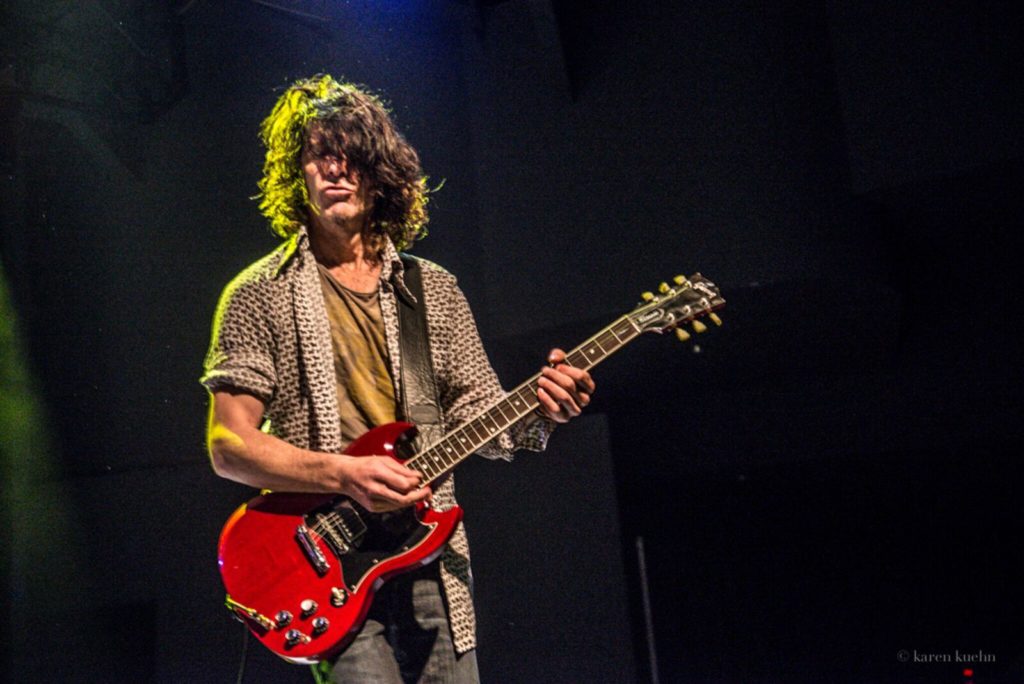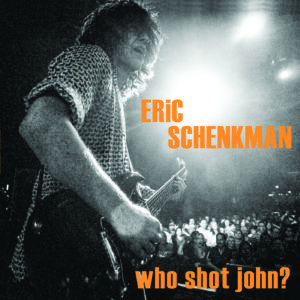
Eric Schenkman loves the blues and loves to perform live. So, it comes as little surprise to learn that the talented musician, songwriter, and vocalist is either woodshedding some new riffs at home, hanging out with other musical pals in studios laying down some seriously superlative new tracks or treading stages all over North America and beyond, plying his trade as a music maker. And he’s a tradesperson whose take on blues music is one infused with a passion for pushing the genre into unique directions, with a firm foundation in the traditions that continue to make it one of the most emotionally and spiritually uplifting of all musical styles.
A regular on the Toronto club scene for nearly two decades, particularly for his weekly raucous blues gig at Grossman’s Tavern, Schenkman is also a songwriter of international stature, best known for being a founding member and primary songwriter for 1990s hitmakers The Spin Doctors. He has also lent his considerable composing and performing talents for collaborations with the likes of Carly Simon, Natalie Merchant, former Jimi Hendrix bassist Noel Redding, Phoebe Snow, and has a nearly two-decade friendship and musical partnership with Corky Laing (Mountain).
Schenkman, who also spent many years in the creative hothouse of New York City, is set to release his latest solo album, Who Shot John? on Jan. 11 through the Vizztone Label Group.
Who Shot John? is not only an excellent demonstration of Schenkman’s versatility as a songwriter but also the diversity and varied nature of the blues genre as a whole. Adding texture, nuance and colour in terms of chords, rhythms to the basic blues structure is crucial to keeping the music interesting and vital both for him as the artist and the audience listening to the album.
“With this record, it’s coming from a blues place because I am a guitar player and I am a songwriter and the form of music is really conducive to what I do. I grew up with it and it’s also a wonderful storytelling form as well. But I also try to vary the styles within the record as well. I think what I am trying to say in a really, really long-winded way is that blues is present the whole time. I know I get frustrated with blues records sometimes. One thing about the blues that can be frustrating is when the story gets sung, and then the guitar and the piano plays exactly the same form and it goes around and around – it gets boring, man,” Schenkman said.
“On this record, I am actually trying to show that it’s not as repetitive as some people think it is. It’s more like there is a percentage of the blues in everything I do. For me, I’ve got to have some blues in my music. All these tunes I am presenting have some degree of blues in them, in some it’s really high, in others it’s a little less. And you have to tip your hat to the form too because it’s a great way to explore your travelogue and tell your stories.
“You can find all sorts of stuff in the blues. There’s a definite link between blues and jazz but I don’t like that much jazz unless I can hear blues in it. I kind of feel that way about rock and roll, and dance music and soul. If I can hear a little blues in it, then I feel I can feel it better.”
 Song ideas were threshed out with three of Schenkman’s long-term music making pals, drummers Van Romaine (Enrique Iglesias/Steve Morse Band) and Cody Dickinson (North Mississippi All Stars) and bassist Shawn Kellerman, who also ended up producing the record.
Song ideas were threshed out with three of Schenkman’s long-term music making pals, drummers Van Romaine (Enrique Iglesias/Steve Morse Band) and Cody Dickinson (North Mississippi All Stars) and bassist Shawn Kellerman, who also ended up producing the record.
Although it sounds like all the musicians were playing together at the same time in the same place, the sessions were actually conducted months apart, with usually just a couple of the players in the room together. But the seamlessness of the performances of these pros, coupled with the mixing mastery of Kellerman, makes it sound like Who Shot John? came from one lively session, directly off the floor and to the listener’s ears.
“The process itself was pretty spontaneous and it started about a year ago. I had a hard drive with some ideas and I just went off to Van’s in New Jersey to hang out and cut some tracks with him on the drums and me on guitar and singing. And that’s when this album started. Really, one day I just realized that I had a bunch of new songs I needed to record, and it started there. It was a combination of wanting to get that done, and also to see Van and Cody because I love being with both those guys. I had been making plans with Van to work together again, and with Cody too, so it all worked out,” he said.
“This record represents a lot of different sides of where I am at right now, but it also sounds just like it would if you walked into the club during one of my shows. It’s a pretty well-oiled machine right now and so I knew working with Van and Cody the songs would light you up just as good on the disc as they would live. I was with Van for a little while and got some bed tracks down, and then went to visit Cody down south for a little while and got some more bed tracks, then went back to Van’s and back to Cody’s and basically put it all together with Shawn Kellerman back in studios in Toronto and Kitchener. We just produced and mixed it until we were all happy.
“And it’s amazing that it sounds so live. That’s exactly how I produce things; that’s always been my production ethic, to always cut live, always get the stuff that you get, not necessarily at first, but to not miss the stuff that really burns, that sticks to the tape as they used to say back in the day. It’s also a great, economical way, for you kids out there, to make records. To cut your tracks with the drummer, particularly if you know the drummer and they’re badass. Cutting with Van and with Cody, I am looking right at them while I am singing the song and I am playing the guitar. I guess the reason why it all sounds like we were together is that I was there for all of it.”
Schenkman grew up in a home immersed in music. His father was a concert cellist and played with some top rated symphony orchestras, including in Toronto. So as a kid, he not only had lots of music playing in the house but also had lots of musicians in the house as well.
“I grew up with lots of records and symphony rehearsals. And my dad was really into anything that had an orchestra on it. So, I got introduced to all the Beatles stuff and Frank Zappa – anything that had a good arrangement or a set of strings in it. My father also played cello on Gordon Lightfoot’s If You Could Read My Mind record, which I thought was pretty cool at the time,” he said, adding that the music education took a different turn once his parents split up.
“I grew up with my mom and she always had a tenant in the house, like a boarder. And this was the early 1970s, so we had one guy from Indiana and he had a 12-string guitar and showed me some stuff. My mom also found a guy around the corner who taught me some other stuff, including some old school picking patterns. And then there were a lot of guitar players around just growing up in Toronto. It was a big a rock and roll town and so I really just sort of picked it all up along the way – I was a fiend for it, there was nothing else that was of interest to me. I started gigging pretty early and I have been at it ever since.
“It was a great scene in Toronto back then. My high school band worked the clubs and we all consumed records like crazy. There were all these great blues bands that would come up from Chicago because there was an amazing circuit that stopped in Toronto at places like Albert’s Hall. And then there were the times when Muddy Waters or B.B. King would come and play at Ontario Place. Not to mention Maple Leaf Gardens where there always seemed to be an amazing show there every week, from Frank Zappa to Supertramp, Boston, Rick Derringer or Neil Young. I saw all those shows I mentioned and more. So, for a kid learning his trade as a musician, it was a wonderful and fantastic place to grow up.”
With Who Shot John? Schenkman is ramping up the solo side of his music career, pushing to elevate it to another level.
“I am really trying to get this out there with PR and publicity and bookings trying to get a toehold into some kind of live circuit that I can push and try to expand a little bit. It’s really the only way I know how to make music. It’s how I did The Spin Doctors too, and what I did with the three other bands that I did before that as well – it’s to start the feeling and expand the repertoire and just try to push out from there,” he said, adding that he also continues to be in regular contact with Laing, with whom he formed the band Cork in the late 1990s, releasing a couple of well-regarded albums.
“I do stuff with Corky all the time. When it comes to that guy, I can’t go anywhere without running into him. As a matter of fact, he just texted me yesterday and we’re planning on getting together pretty soon. Track 2 on this record is a song called Locked in the House All Day, and it’s a Corky Laing/Eric Schenkman song. We’re old pals; I have known him for a long time and we have done a lot of work together. One of the greatest things about getting older and working your craft is these relationships can deepen and, creatively, that can be really great.”
What is also ‘really great’ is the anticipation from fans for Who Shot John? as well as the plaudits and esteem by which the album is already being received by critics and the industry. With summers consumed with tour dates for The Spin Doctors, Schenkman said he is concentrating on getting out and playing as much as he can this winter and next spring.
For more information and tour dates, visit https://ericschenkman.com.
- Jim Barber is a veteran award-winning journalist and author based in Napanee, ON, who has been writing about music and musicians for a quarter of a century. Besides his journalistic endeavours, he now works as a communications and marketing specialist. Contact him at jimbarberwritingservices@gmail.com.
